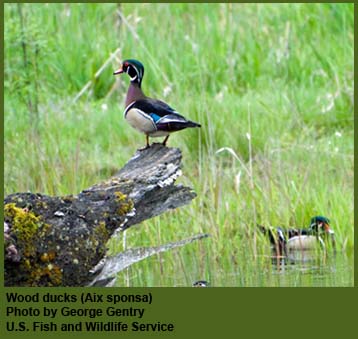Links
America’s Wetlands: Our Vital Link Between Land and Water
From the U.S. Environmental Protection Agency
http://www.epa.gov/wetlands
This site will give you a better understanding of the rich variety of wetlands, their importance, how they are threatened, and what can be done to conserve them for future generations.
Mossom Creek Hatchery
http://www.mossomcreek.org/
Mossom Creek Hatchery is a salmon hatchery in Port Moody, British Columbia. It is a salmon enhancement project supported by Fisheries and Oceans Canada. It was started in 1976 by high school volunteers from local Centennial School in Coquitlam and teachers Ruth Foster and Rod MacVicar. They formed the Centennial School Salmon project which is still an active club at the school. It has received much recognition for its unique and longstanding work.
When the hatchery began, there were no salmon left in Mossom Creek. Thanks to the tireless efforts of volunteers over the decades there is now a strong run of Chum Salmon and an increasing run of Coho Salmon. The hatchery also supplies fish to other streams that drain into Burrard Inlet. By reintroducing these salmon, the hatchery strengthens the surrounding ecosystem at various trophic levels. Every year the hatchery releases approximately 100,000 Chum fry into the area and between 5,000 and 10,000 Coho smolts.
National Wetlands Inventory
From the U.S. Fish and Wildlife Service
http://www.fws.gov/wetlands/
The U.S. Fish and Wildlife Service is the principal Federal agency that provides information to the public on the extent and status of the Nation's wetlands. The agency has developed a series of topical maps to show wetlands and deepwater habitats. This geospatial information is used by Federal, State, and local agencies, academic institutions, and private industry for management, research, policy development, education and planning activities. Digital data can be viewed and downloaded through several methods.
Surf Your Watershed
From the U.S. Environmental Protection Agency
http://cfpub.epa.gov/surf/locate/index.cfm
Locate your watershed by entering your ZIP code or the name of a stream, city, tribe, lake, school, airport, and more.
Teaching about Wetlands
From the U.S. Environmental Protection Agency
http://www.epa.gov/wetlands/wetlands-education
Why is a wetland important? Many people can’t answer this question with confidence. Although the public’s appreciation of wetlands is increasing, wetland studies have often been omitted from school curricula in the past. Once young people learn about the value of wetlands, they have the tools to become active citizens working to protect this critical feature of the environment for future generations.
Wetland Types
From the U.S. Geological Survey
http://www.nwrc.usgs.gov/topics/wetlands/wetlandTypes.htm
Wetlands are identified by many common names such as marshes, swamps, potholes, bogs, fens, pocosins, vernal pools, or playa lakes. Wetlands vary because of differences in soils, topography, climate, hydrology, water chemistry, vegetation, and human disturbance. As a result of this diversity, and the need to inventory wetlands and regulate their use, there are numerous definitions and classifications.
Wetlands
From Missouri Botanical Garden
http://www.mbgnet.net/fresh/wetlands/index.htm
Click through this web site and learn about the many types of wetlands, their importance, and the various wetland animals.











